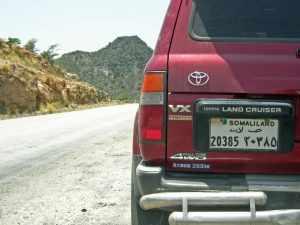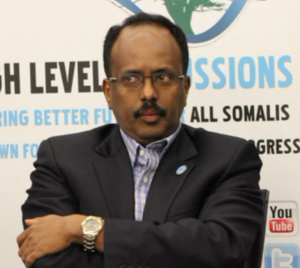On October 15, a truck full of explosives crashed through a barrier near the Safari Hotel in Mogadishu’s commercial district. The bombs killed at least 358 Somalis and wounded over 400 more. Two weeks later, another suicide driver murdered at least 27 people, prompting the municipal government to issue a daytime ban on trucks inside the city limits. But the world’s biggest terror attack in a decade went largely unnoticed internationally, merely another example of the mindless violence that has gripped Somalia for decades.
Embattled by Islamist insurgency, piracy, and famine, Somalia has become synonymous with chronic instability. UNICEF estimates that 275,000 Somali children are in a life-threatening conditions; over 1.1 million have fled the country.
Fathi Hiis, 17, survived a perilous journey overland and across the Mediterranean Sea to escape Somalia. He now lives in Vienna, Austria, while the rest of his family remains at home. “Somalia is dangerous,” Hiis told the HPR.
Somalia, which has topped the Fragile States Index for eight of the past ten years, has descended into chaos and anarchy over the past quarter century. Though current efforts at state building slowly seem to be bearing fruit, the country nonetheless faces a host of seemingly insurmountable challenges. Strong centrifugal tendencies, an ineffective central government, dependence on foreign actors, and the threat of Islamist insurgency all hamper unity in the country.
A Country without a State
After resistance movements toppled the unpopular military junta of Siad Barre in 1991, Somalia was divided between different local warlords and militias. In 2006, the “Transitional Federal Government,” an alliance of warlords supported by Ethiopia, was able to retake the Somali capital of Mogadishu from the control of the Union of Islamic Courts. But the new regime’s secular outlook caused massive backlash from the radical former youth wing of the now-defunct Union of Islamic Courts: al-Shabab. Since then, change has been painfully slow.
After 25 years of fragmentation, central institutions are only a distant memory for most Somalis. As the federal government disappeared, control was increasingly administered by influential clans and around local power structures. “After everything was ruined, they got back to their roots,” David Anderson, professor at the University of Warwick and an expert on Kenya and Somalia, told the HPR. Today, both international and domestic actors tend to favor a federal system of government. “Federalization is probably the right approach to bring the country back piece by piece,” David Akopyan, the Somalia United Nations Development Program’s deputy director, affirmed in an interview with the HPR.

A Somalilander license plate, September 2007.
Despite its ethnic homogeneity in comparison to other African states, Somalis, too, overwhelmingly favor local institutions for public participation. Accordingly, the recently-adopted Somali constitution outlines a federal system of government, in which each constituent state effectively has its own parliament, judicial system, and army. These states can even conduct their own foreign policy. “It’s a bit of a messy process,” admitted Akopyan, who fears that federalism might deteriorate into feudalism. Some regions may already be lost for the Somali government. Somaliland, for example, has been de facto independent since the 1990s.
This drift toward decentralization, however, is not without reason: trust in Somalia’s central government is extremely low, a legacy of Barre’s oppressive regime. Transparency International regularly ranks Somalia as the most corrupt country in the world. According to one report, 70 percent of funds were misappropriated by the Transitional Federal Government in power from 2004 to 2012. Recent elections, though widely lauded by the international community, have been mired by allegations of rampant corruption. “Every day there are political problems,” recounted Hiis.
Standing on the U.N.’s Shoulders
The influence of foreign actors has further undermined the government’s autonomy and legitimacy. For the past 40 years, Somalia has had a fraught relationship with its two large Christian-majority neighbors, Ethiopia and Kenya. In 2011, Kenya decided to intervene to stop the spread of al-Shabab, deploying troops under the umbrella of the African Union “peacekeeping” mission AMISOM. In an effort to encourage local involvement, the United Nations has turned a blind eye to the use of soldiers from neighboring states, usually taboo for U.N. peacekeeping missions. In early November, , hundreds of Ethiopian troops entered Somali territory.
Their intervention has inhibited the emergence of strong Somali national forces. “Somalia has no real army,” Hiis agreed. The presence of soldiers from historical and religious adversaries has further weakened legitimacy for the Somali government. “Ethiopians and Kenyans are seen as an occupying force, and Somalis hate them,” said Anderson. “They know that AMISOM is effectively an army of occupation.”

“Farmajo,” the current president of Somalia, in April 2014.
Senior Somali officials admit that Mogadishu would be overrun within a month by al-Shabab without military support from AMISOM. Yet the AMISOM forces, Anderson explained, have not been able to consolidate the gains made against al-Shabab. Today, al-Shabab forces are estimated to number between 7,000 and 9,000 fighters. In the areas under its control, the extremists, allied with al-Qaeda, have introduced a radical version of Sharia law. “There is no evidence at all to support the idea that al-Shabab is destroyed or struggling or suffering,” Anderson stated. If anything, al-Shabab is becoming more efficient: its terrorist attacks are today deadlier than ever before. There is little popular support for the group’s fundamentalist Wahhabi ideology: most Somali Muslims identify with the mystic strand of Sufism. But dire economic conditions and the federal government’s lack of legitimacy have played into the hands of the mujahideen.
Time for Change
Still, not all is lost for Somalia. Akopyan argued that the situation is slowly improving. “Somalis ten years ago didn’t have airports, roads, immigration; everything was ruined and destroyed.” In 2017, Somalia’s Electoral College selected Mohamed Abdullahi Mohamed to head the country. “Farmajo,” as he is nicknamed, also holds U.S. citizenship and earned a reputation for honesty and trustworthiness during a stint as prime minister in 2011. Akopyan called the outcome of the election “relatively promising,” citing the peaceful transfer of power and increased representation of women and young people.
Moreover, the public’s reaction to the horrific October bombing gives reason for hope. In the aftermath of the attack, people took to the streets in protest of the terrorists, wearing red cloth to show their solidarity with the victims. Al-Shabab’s cynical calculations have backfired. Ironically, the terrorist group may have helped create something the government has struggled to all this time: a sense of national unity in the war-torn country.
Image credit: Flikr/AMISOM Public Information // Flikr/Carl Montgomery // Wikimedia/Deeqosonna Warsame
